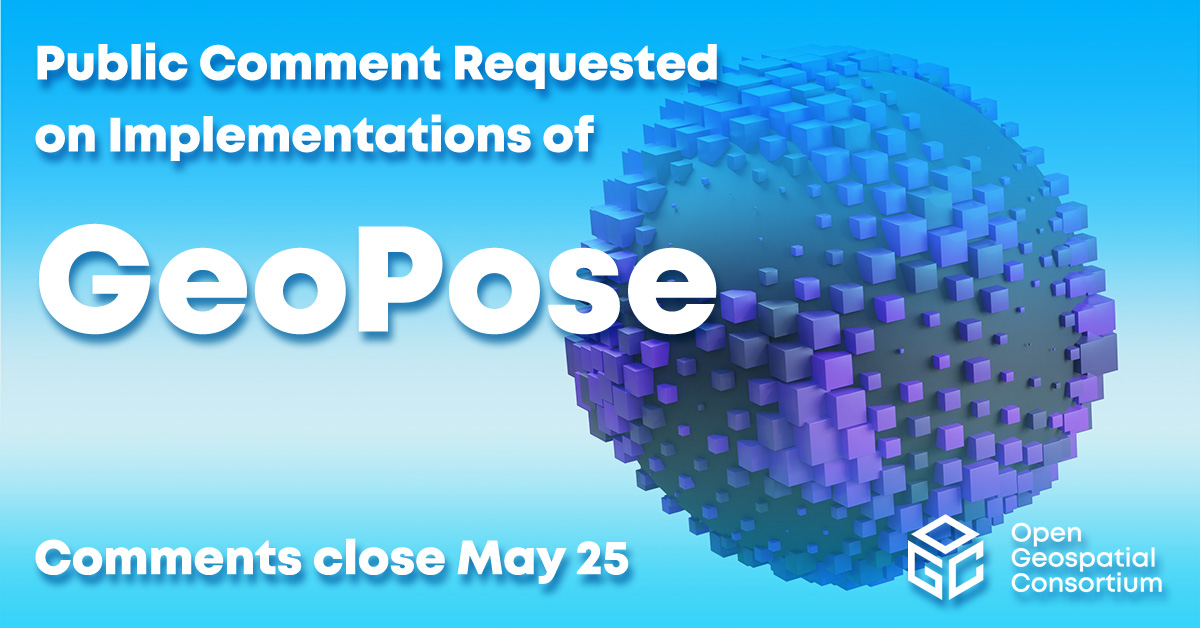Request Closed: April 25, 2023 9:00 am — May 25, 2023 11:59 pm
The Open Geospatial Consortium (OGC) seeks public comment on the evidence of implementation of GeoPose 1.0 specification and whether the Standard is ready to be uplifted from Draft to Adopted status. Comments are due by May 25, 2023.
OGC Standards are approved at a Draft status until evidence of implementation is provided. The GeoPose Standard was initially approved on 20 June, 2022, and there are now three independent implementations. The public is requested to review this evidence and comment, as needed.
The OGC GeoPose Standard, which provides a standard for expressing and sharing geographically-anchored poses (aka GeoPoses) of objects in six degrees of freedom and referenced to one or more standardized Coordinate Reference Systems (CRS).
The combination of position (e.g. x, y, z or longitude, latitude, elevation) and orientation (e.g. pitch, roll, and yaw) with six degrees of freedom for objects is usually referred to as the object’s “pose.” Pose can be expressed as being in relation to other objects, a place, and/or to the user. When a pose is defined relative to the Earth, it is called a geographically anchored pose, or ‘GeoPose’ for short.
The ability to specify and express the GeoPose of any object will aid in interoperability between 3D spatial computing systems such as Metaverse applications, those for autonomous vehicles, augmented, virtual, and extended reality (AR/VR/XR), 3D map visualization, or any digital representation of the physical world or part therein, such as digital twins. Further, the ability to express and interchange the GeoPose of an object in a consistent fashion will aid applications involving Earth Observation from spacecraft and aircraft with sensors mounted on rotatable gimbals.
OGC has introduced a standard way to express a geospatially anchored pose. The GeoPose 1.0 standard supplies both context and an unambiguous JSON encoding that works across a range of technologies from GIS, 3D environments, IoT, and autonomous vehicles to aerospace.
The candidate OGC GeoPose Standard specifies eight standardization targets: two “Basic” forms with no configuration options for common use cases, an “Advanced” form with more flexibility for more complex applications, and five composite structures that support time series plus chain and graph structures. The candidate GeoPose Standard is modular, flexible, and designed to meet the requirements of a range of use cases and enable the exchange of GeoPose information between them.
OGC Members interested in staying up to date on the progress of this standard, or contributing to its development, are encouraged to join the GeoPose SWG via the OGC Portal or follow the OGC GeoPose GitHub repository.
Further information on the OGC GeoPose Standard is available on the OGC Website. The list of existing known GeoPose implementations is available here. Comments are due by May 25, 2023, and should be submitted via the method below.
To Comment:
Comments can be submitted to a dedicated email reflector for a period ending on the “Close request date” listed above. Comments received will be consolidated and reviewed by OGC members for incorporation into the document. Please submit your comments via this email address, using this Comments Template for the message body.
Subscribe to Comments:
You may wish to subscribe to the distribution list to receive comments as they are submitted. Subscribing to the list will also allow you to view comments already received, which can be found in the List Archives.
